1998 PONTIAC BONNEVILLE child lock
[x] Cancel search: child lockPage 17 of 395
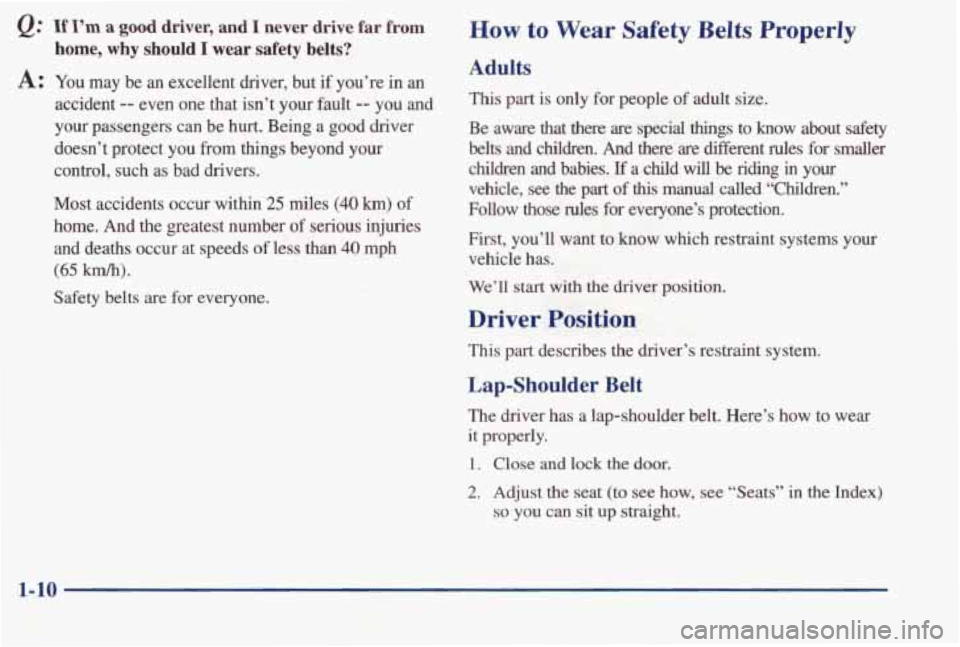
Q: If I’m a good driver, and I never drive far from
home, why should I wear safety belts?
A: You may be an excellent driver, but if you’re in an
accident -- even one that isn’t your fault -- you and
your passengers can be hurt. Being a good driver
doesn’t protect you from things beyond
your
control, such as bad drivers.
Most accidents occur within
25 miles (40 km) of
home. And the greatest number
of serious injuries
and deaths occur at speeds
of less than 40 mph
(65 km/h).
Safety belts are for everyone.
How to Wear Safety Belts Properly
Adults
This part is only for people of adult size.
Be aware that there are special things to know about safety
belts and children. And there are different rules for smaller
children and babies.
If a child will be riding in your
vehicle, see the part of this mand called “Children.”
Follow those rules for everyone’s protection.
First, you’ll want to know which restraint systems your
vehicle has.
We’ll start with the driver position.
Driver Position
This part describes the driver’s restraint system.
Lap-Shoulder Belt
The driver has a lap-shoulder belt. Here’s how to wear
it properly.
1. Close and lock the door.
2. Adjust the seat (to see how, see “Seats” in the Index)
so you can sit up straight.
1-10 - .
Page 25 of 395
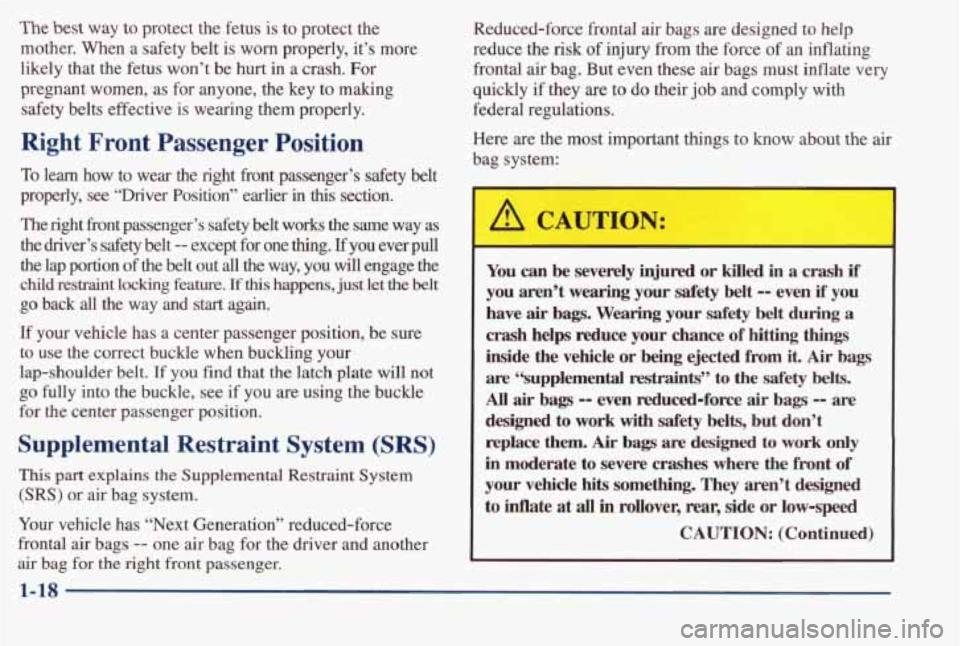
The best way to protect the fetus is to protect the
mother. When a safety belt is
worn properly, it’s more
likely that the fetus won’t be hurt in a crash. For
pregnant women, as for anyone, the key to making
safety belts effective is wearing them properly.
Right Front Passenger Position
To learn how to wear the right front passenger’s safety belt
properly,
see “Driver Position’’ earlier in this section.
The right fiont passenger’s safety belt works the same way
as
the driver’s safety belt -- except for one thing. If you ever pull
the lap portion of the belt out
all the way, you will engage the
child restraint locking feature. If this happens, just let the belt
go back all the way and start again.
If your vehicle has a center passenger position, be sure
to use the correct buckle when buckling your
lap-shoulder belt.
If you find that the latch plate will not
go fully into the buckle, see if you are using the buckle
for the center passenger position.
Supplemental Restraint System (SRS)
This part explains the Supplemental Restraint System
(SRS) or air bag system.
Your vehicle has “Next Generation” reduced-force
frontal air bags
-- one air bag for the driver and another
air bag for the right front passenger. Reduced-force frontal
air bags
are designed to help
reduce the
risk of injury from the force of an inflating
frontal
air bag. But even these air bags must inflate very
quickly
if they are to do their job and comply with
federal regulations.
Here are
the most important things to know about the air
bag system:
I
pu can be severely injured or killed in a crash if
you aren’t wearing your safety belt -- even if you
have
air bags. Wearing your safety belt during a
crash helps reduce your chance of hitting things
inside the vehicle or being ejected from it. Air bags
are “supplemental restraints” to the safety belts.
All air bags -- even redud-force air bags -- are
designed to work with safety belts, but don’t
replace them. Air bags ace designed to work only
in moderate to severe crashes where the front of
your vehicle hits something. They aren’t designed
to Mate at all in rollover, rear, side or low-speed
CAUTION: (Continued)
Page 61 of 395
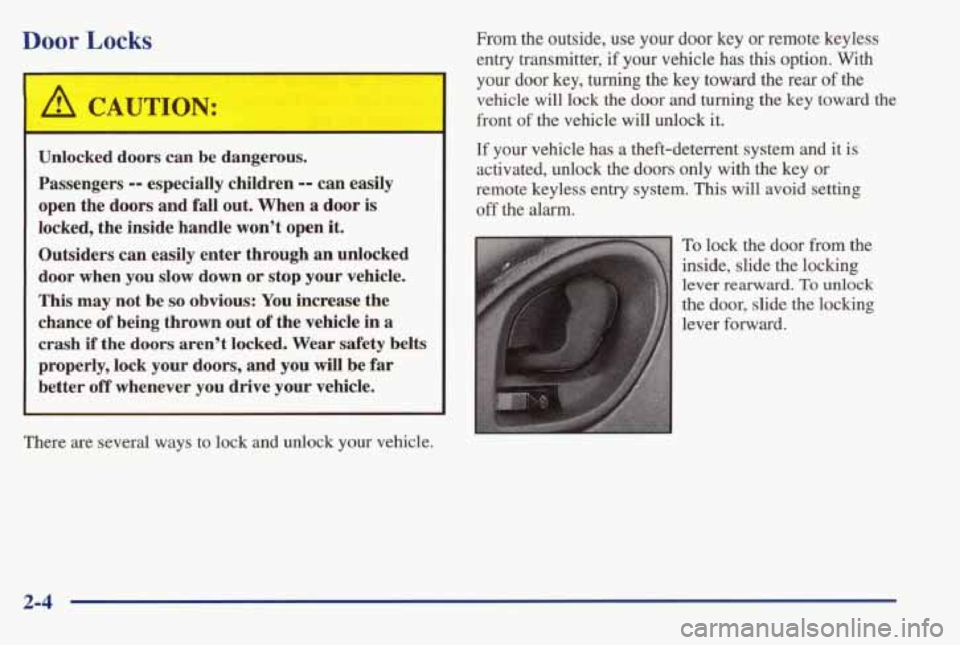
Door Locks
A CAUTION:
~
I
Unlocked doors can be dangerous. Passengers
-- especially children -- can easily
open the doors and fall out. When
a door is
locked, the inside handle won’t open it.
Outsiders can easily enter through an unlocked
door when you slow down or stop your vehicle.
This may not be
so obvious: You increase the
chance of being thrown out of the vehicle in a
crash if the doors aren’t locked. Wear safety belts
properly, lock your doors, and you will be far
better
off whenever you drive your vehicle.
mere are several ways to lock and unlock your vehicle. From the outside,
use your door key
or remote keyless
entry transmitter,
if your vehicle has this option. With
your door key, turning the key toward the rear of the
vehicle will lock the door and turning the key toward the
front of the vehicle will unlock
it.
If your vehicle has a theft-deterrent system and it is
activated, unlock the doors only with the key or
remote keyless entry system.
This will avoid setting
off the alarm.
To lock the door from the
inside, slide the locking
lever rearward. To unlock
the door, slide the locking
lever forward.
2-4
Page 66 of 395
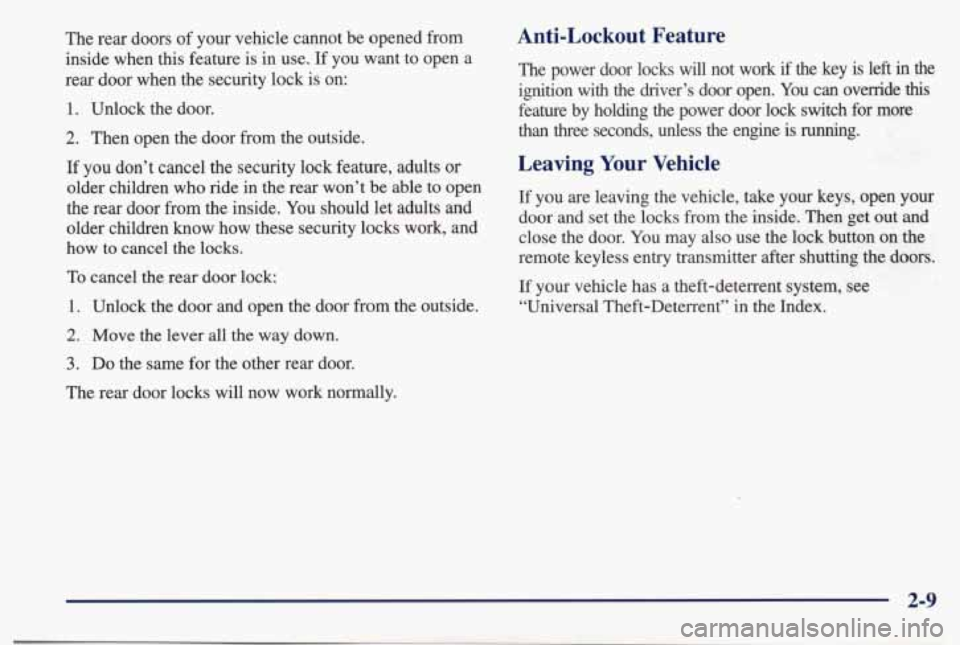
The rear doors of your vehicle cannot be opened from
inside when
this feature is in use. If you want to open a
rear door when the security lock is on:
1. Unlock the door.
2. Then open the door from the outside.
If you don’t cancel the security lock feature, adults or
older children who ride in the rear won’t be able to open
the rear door
from the inside. You should let adults and
older children know how these security locks work, and
how to cancel
the locks.
To cancel the rear door lock:
1. Unlock the door and open the door from the outside.
2. Move the lever all the way down.
Anti-Lockout Feature
The power door locks will not work if the key is left in the
ignition with the driver’s door open. You can override this
feature by holding the power door lock switch for more
than three seconds, unless the engine is running.
Leaving Your Vehicle
If you are leaving the vehicle, take your keys, open your
door and set the locks from the inside. Then get out and
close the door. You may also use the lock button on the
remote keyless
entry transmitter after shutting the doors.
If your vehicle has a theft-deterrent system,
see
“Universal Theft-Deterrent” in the Index.
3. Do the same for the other rear door.
The rear door locks will now work normally.
2-9
Page 375 of 395
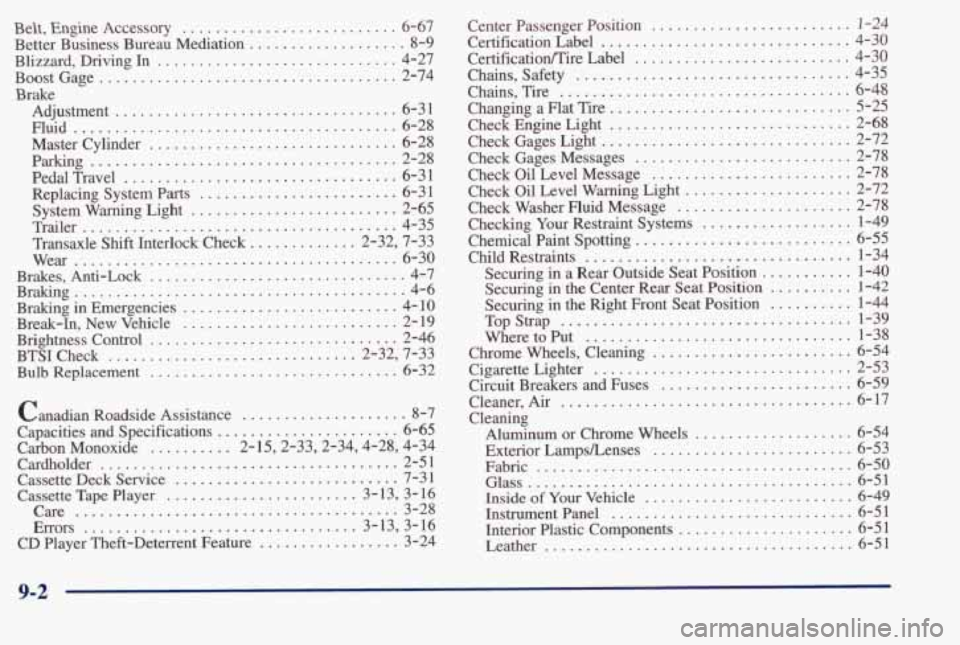
Belt. Engine Accessory .......................... 6-67
Better Business Bureau Mediation
................... 8-9
Blizzard. Driving In
............................. 4-27
Boost Gage
.................................... 2-74
Adjustment
.................................. 6-3 1
Master Cylinder
.............................. 6-28
Parking ..................................... 2-28
Pedal Travel
................................. 6-3 1
Replacing System Parts
........................ 6-31
System Warning Light
......................... 2-65
Trailer
...................................... 4-35
Transaxle
Shift Interlock Check ............. 2-32. 7-33
Wear
....................................... 6-30
Brakes.Anti -Lock ............................... 4-7
Braking
........................................ 4-6
Braking in Emergencies
.......................... 4- 10
Break-In.
New Vehicle .......................... 2- 19
Brightness Control
.............................. 2-46
BTSI Check
.............................. 2-32, 7-33
Bulb Replacement
.............................. 6-32
Brake
Fluid
....................................... 6-28
Canadian Roadside Assistance
.................... 8-7
Capacities and Specifications
...................... 6-65
Carbon Monoxide
.......... 2.15.2.33.2.34.4.28. 4.34
Cardholder
.................................... 2-51
Cassette Deck Service ........................... 7-31
Cassette Tape Player
....................... 3-13. 3-16
Care
....................................... 3-28
Errors
................................. 3-13, 3-16
CD Player Theft-Deterrent Feature ................. 3-24 Center Passenger Position
. . , ........ ..... 1-24
CertificationLabel .............................. 4-30
CertificationEire Label
.......................... 4-30
Chains, Safety
................................. 4-35
Chains, Tire
................................... 648
Changing a Flat Tire .............................. 5-25
Check Engine Light
............................. 2-68
Check Gages Light
.............................. 2-72
Check Gages Messages
.......................... 2-78
Check Oil Level Message
........................ 2-78
Check
Oil Level Warning Light .................... 2-72
Check Washer Fluid Message
..................... 2-78
Checking
Your Restraint Systems .................. 1-49
Chemical Paint Spotting
.......................... 6-55
Securing
in the Center Rear Seat Position .......... 1-42
ChildRestraints ................................ l-34
Securing in a Rear Outside Seat Position ........... 1-40
Securing
in the Right Front Seat Position .......... 1-44
TopStrap ................................... 1-39
WheretoPut
................................ l-38
Chrome Wheels, Cleaning ........................ 6-54
Cigarette Lighter
............................... 2-53
Circuit Breakers and Fuses
....................... 6-59
Cleaner,
Air ................................... 6-17
Cleaning Aluminum or Chrome Wheels
................... 6-54
Exterior Lamps/Lenses
........................ 6-53
Fabric
...................................... 6-50
Glass
....................................... 6-51
Inside
of Your Vehicle ......................... 6-49
Instrument Panel ............................. 6-51
Interior Plastic Components
..................... 6-51
Leather
..................................... 6-51
9-2
Page 381 of 395
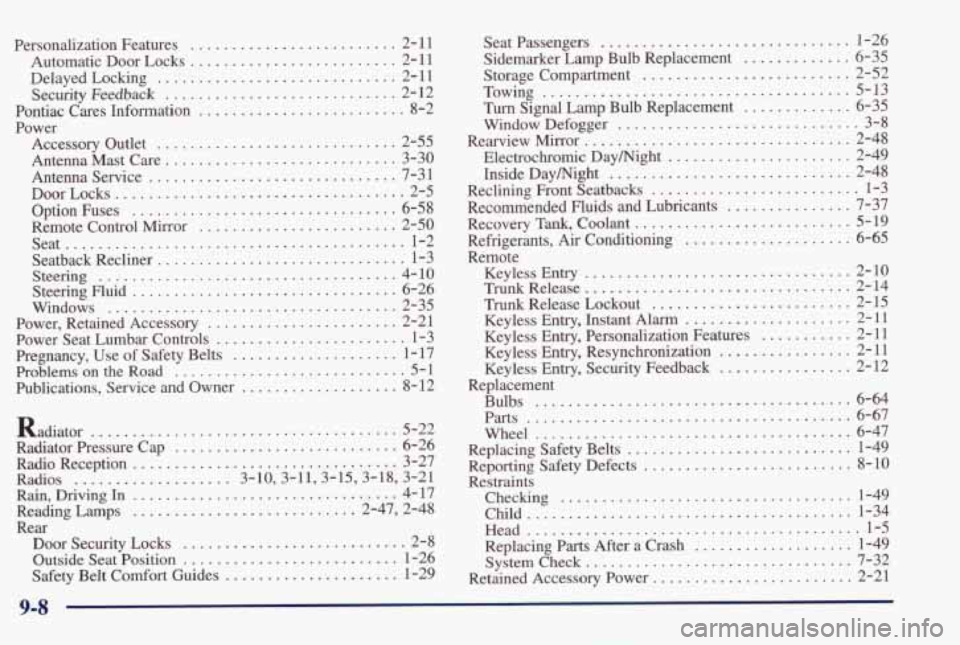
Personalization Features ......................... 2- 11
Automatic Door Locks
......................... 2- 11
Delayed Locking
............................. 2- 11
Security
Feedback ............................ 2- 12
Pontiac Cares Information
......................... 8-2
Power Accessorv Outlet
............................. 2-55 d
AntennaMastCare ............................ 3-30
AntennaService
.............................. 7-31
DoorLoc
ks ................................... 2-5
Remote Control Mirror
........................ 2-50
Seat
......................................... 1-2
Seatback Recliner
.............................. 1-3
Steering
.................................... 4-10
Steering Fluid ................................ 6-26
Windows
................................... 2-35
Power, Retained Accessory
....................... 2-21
Power Seat Lumbar Controls
....................... 1-3
Pregnancy, Use
of Safety Belts .................... 1-17
Problems
on the Road ............................ 5-1
Publications, Service and Owner
................... 8-12
Option Fuses
................................ 6-58
Radiator
................................... 5-22
Radiator Pressure Cap
........................... 6-26
RadioReception
................................ 3-27
Radios
................... 3.10.3.11.3.15.3.18. 3.21
Rain. Driving In ................................ 4-17
Reading Lamps
........................... 2.47. 2.48
Door Security Locks
........................... 2-8
Outside Seat
Position .......................... 1-26
Safety Belt Comfort Guides
..................... 1-29
Rear Seat Passengers
.............................. 1-26
Sidemarker Lamp Bulb Replacement
............. 6-35
Storage Compartment ......................... 2-52
'Ih Signal Lamp Bulb Replacement ............. 6-35
Window Defogger
............................. 3-8
Electrochromic Daymight
...................... 2-49
Inside Daymight
............................. 2-48
Reclining Front Seatbacks
......................... 1-3
Recommended Fluids and Lubricants
............... 7-37
Recovery
Tank, Coolant .......................... 5-19
Refrigerants, Air Conditioning .................... 6-65
Keyless
Entry ................................ 2-10
Trunk Release ................................ 2-14
Trunk Release Lockout ........................ 2-15
Keyless
Entry, Instant Alarm .................... 2-11
Keyless Entry, Personalization Features ........... 2-11
Keyless
Entry, Resynchronization ................ 2-11
Keyless
Entry, Security Feedback ................ 2-12
Towing
..................................... 5-13
RearviewMirror ................................ 2-48
Remote
Replacement Bulbs
...................................... 6-64
Parts ....................................... 6-67
Wheel 6-47
....................................
Replacing Safety Belts ............... ....... 1-49
Reporting Safety Defects
......................... 8-10
Restraints Checking
,..,............................... l-49
Child ....................................... l-34
Head ........................................ 1-5
Replacing
Parts After a Crash ................... 1-49
Retained Accessory Power
........................ 2-21
Systemcheck
................................ 7-32
9-8
Page 386 of 395
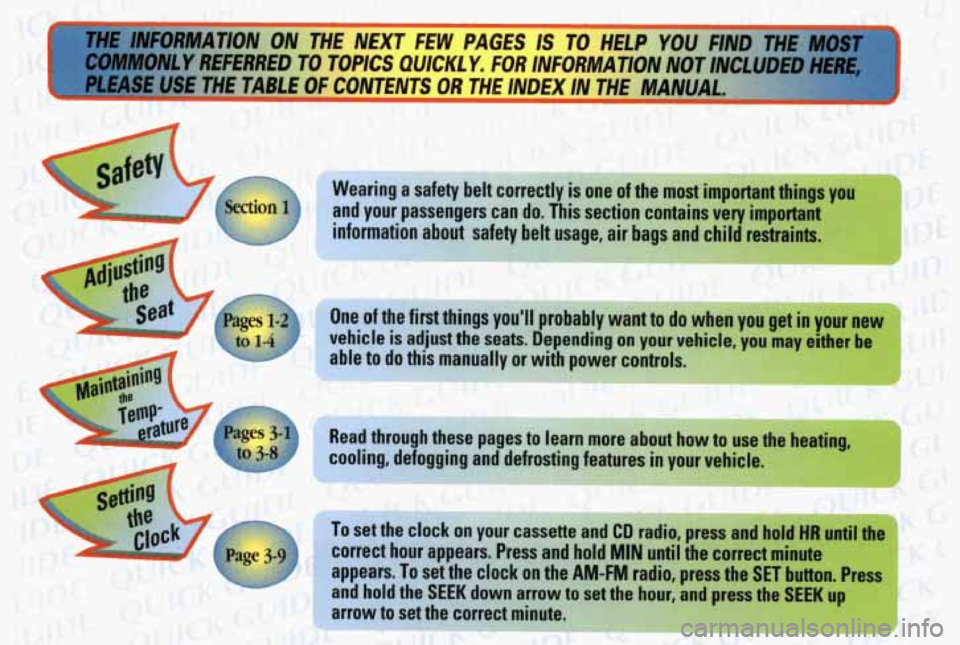
I rm rrUFORMATlON ON THE NEXT FEW PAGES IS
COMMONLY REFERRED TO TOPICS QUICK1 Y. FOR INFORMATION NOT INCLUDED HERE,
Pi USE THETA"" CONTENTS OR THE INDEX IN THE MANUA- -
-7
gaf e"'
rearing a safety belt correctly is one of the most important things you
and your passengers can do.
This section contains very important
information about safety
belt usage, air bags and child restraints. ., ..l .
-* , . .,! " .is'. ' ,,,, ": , , 3, '< 1: '
One of the first things you'll probably want to do when you get in your new
vehicle is adjust the seats. Depending on your vehicle, vou mav either be
Read through these pages
to learn more about how to use the heatina.
cooli
, defoggin4 and defrosting features in VOL leh
To set the clock on your cassene ana LU raalo, press ana hold HK untll the
correct hour appears. Press and hold
MIN until the correct minute
appears.
To set the clock on the AM-FM radio, press the SET button. Press
and hold the
SEEK down arrow to set the hour, a up I. '1'
arrow to set the correct minute. pu:' 1 ,I - ;: ,,#y 1. y7; :- ' 2 2 '.->'